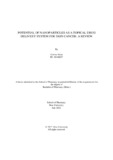| dc.contributor.advisor | Sheikh, Zara | |
| dc.contributor.author | Islam, Karima | |
| dc.date.accessioned | 2022-12-13T03:41:13Z | |
| dc.date.available | 2022-12-13T03:41:13Z | |
| dc.date.copyright | 2022 | |
| dc.date.issued | 2022-07 | |
| dc.identifier.other | ID 18146027 | |
| dc.identifier.uri | http://hdl.handle.net/10361/17638 | |
| dc.description | This thesis is submitted in partial fulfillment of the requirements for the degree of Bachelor of Pharmacy, 2022. | en_US |
| dc.description | Cataloged from PDF version of thesis. | |
| dc.description | Includes bibliographical references (pages 38-68). | |
| dc.description.abstract | Skin cancer is among the most widespread and challenging forms of cancer, with high death rates globally, the seventeenth most prevalent cancer in the world. Conventional treatment options for skin cancer, including surgical procedures, immunotherapy, radiation therapy, chemical peels, photodynamic therapy, chemotherapy, topical therapy, curettage and electrodesiccation, and cryotherapy, have many limitations which could be surpassed by the use of nanoparticle-based drug delivery systems. In addition to providing targeted treatment for skin cancer, nanoparticle-based drug carriers have the ability to improve the bioavailability, specificity, and therapeutic effectiveness of anti-cancer drugs and increase patient adherence. The present review summarizes the potential of different categories of nanoparticles that are currently being explored in order to treat and diagnose skin cancer. A brief introduction about the different types of skin cancer has also been included, followed by the application of nanoparticles-based therapy for the treatment of these different types of skin cancer. In the end, the challenges related to the formulation and development of nanoparticles for skin cancer and the current progress of use of this specialized drug delivery system have been highlighted with a direction towards ways to overcome these challenges. | en_US |
| dc.description.statementofresponsibility | Karima Islam | |
| dc.format.extent | 68 pages | |
| dc.language.iso | en | en_US |
| dc.publisher | Brac University | en_US |
| dc.rights | Brac University theses are protected by copyright. They may be viewed from this source for any purpose, but reproduction or distribution in any format is prohibited without written permission. | |
| dc.subject | Nanoparticle | en_US |
| dc.subject | Skin cancer | en_US |
| dc.subject | Nanotechnology | en_US |
| dc.subject | Melanoma | en_US |
| dc.subject.lcsh | Cancer | |
| dc.title | Potential of nanoparticles as a topical drug delivery system for skin cancer: a review | en_US |
| dc.type | Thesis | en_US |
| dc.contributor.department | Department of Pharmacy, Brac University | |
| dc.description.degree | B. Pharmacy | |

